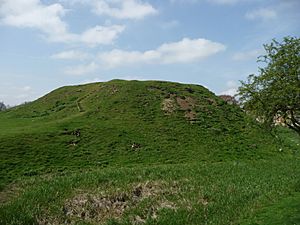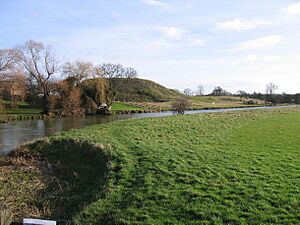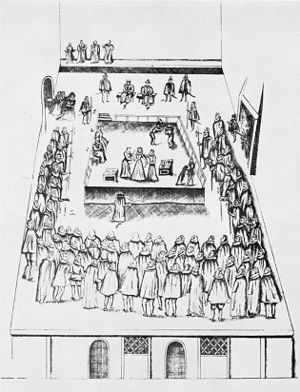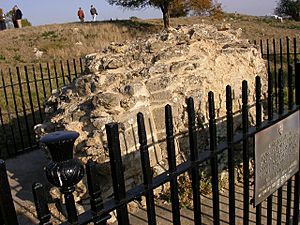Fotheringhay Castle facts for kids

Fotheringhay Castle was an important motte-and-bailey castle in England. It was built by the Normans around 1100. The castle was located in the village of Fotheringhay, about 5.6 kilometers north of Oundle, Northamptonshire.
It was likely started by Simon de Senlis. Later, in 1113, it passed to Prince David of Scotland when he married Simon's widow. The castle stayed with Scottish princes until the early 1200s. Then, King John of England took control of it.
By 1220, Ranulf de Blondeville, 6th Earl of Chester controlled Fotheringhay Castle. In 1221, William II de Forz, 3rd Earl of Albemarle briefly captured it during a rebellion. But he soon left, and King Henry III took it over. The castle remained a royal property until the time of King Edward II.
Fotheringhay Castle was a favorite home for the Dukes of York. King Richard III was born there in 1452. It was also the last prison for Mary, Queen of Scots. She was tried and executed at the castle in 1587.
The castle was taken apart in the 1630s. Most of its stone was removed, leaving only the earth mounds. Today, the site is a protected historical site and is open to visitors.
History of Fotheringhay Castle

After William the Conqueror took over England, he gave the land around Fotheringhay to Judith of Lens. Her daughter, Maud, inherited Fotheringhay. Around 1090, Maud married Simon de Senlis. He became the Earl of Huntingdon. Around 1100, Simon started building Fotheringhay Castle. It was located on the north side of the River Nene.
Simon died by 1113. King Henry I then arranged for Maud to marry Prince David of Scotland. David later became King of Scotland. Through this marriage, he gained Fotheringhay Castle. The castle stayed with Scottish princes until the 1200s.
In 1212, King John was having problems with the church. He demanded that his powerful nobles send him hostages to prove their loyalty. He used this to get Fotheringhay Castle from David, Earl of Huntingdon. King John wrote to the earl, saying he wanted the castle because David had given his son as a hostage. This is the first time the castle is mentioned in official records.
Between 1208 and 1214, King John took many castles from his nobles. This made them unhappy. To make peace, John started returning castles in 1215. Fotheringhay was one of the castles he gave back.
David, Earl of Huntingdon, later rebelled against the king. His property was then given to William Marshal, 2nd Earl of Pembroke. In 1218, Marshal was told to return the earl's lands. But he kept Fotheringhay Castle. When David died in 1219, the Earl of Pembroke still held Fotheringhay.
Alexander II, King of Scotland, had a claim to the castle through David. It was also meant to be part of the dowry for Joan, King Henry III's sister. She was going to marry the Scottish king. Finally, on December 3, 1219, Marshal gave Fotheringhay Castle to the English king.
In 1221, Hubert de Burgh, 1st Earl of Kent, was put in charge of Fotheringhay Castle. This happened when he married the King of Scotland's sister. But the castle was still controlled by the English king, Henry III.
William II de Forz, 3rd Earl of Albemarle, rebelled against Henry III in late 1220. In January 1221, he captured Fotheringhay Castle. He put his own soldiers there. He attacked other castles that month, but Fotheringhay was his only success. A royal letter said he "secretly and rebelliously seized the castle of Fotheringhay". He was "destroying our land and disturbing our peace". When a large royal army gathered, Forz ran north. Henry III then took Fotheringhay and Castle Bytham. Henry III kept control of Fotheringhay Castle. It remained a royal castle until the time of King Edward II.
During the Second Barons' War, Fotheringhay Castle was taken by Robert de Ferrers, 6th Earl of Derby. He held it from 1264 to 1265. Edward II later gave Fotheringhay Castle to John of Brittany, Earl of Richmond. When John died in 1334, his niece Marie de St Pol inherited the castle. She was the widowed Countess of Pembroke. She died in 1377.
King Edward III then gave the castle to his son, Edmund Langley. In 1385, Edmund was made Duke of York. Fotheringhay Castle became his main home. A writer named John Leland said in 1540 that Langley spent a lot of money on Fotheringhay Castle. Langley died in 1402. His oldest son, Edward, took over. Edward died in 1415 without children. So, his property went to his nephew, Richard.

Fotheringhay Castle was a favorite home for Richard, who became Duke of York. He was a very powerful noble. He was married to Cecily Neville, from an important family in northern England. They had two sons who later became kings: Edward IV and Richard III. Richard III was born at Fotheringhay Castle in 1452.
On March 27, 1454, Richard, Duke of York, was named "protector and defender of the realm". This happened while King Henry VI was ill. Richard stayed in this role until February 9, 1455. Later, during the Wars of the Roses, the Duke of York was killed in the Battle of Wakefield in 1460. The Wars of the Roses were a series of fights between the York and Lancaster families for the English throne.
Fotheringhay Castle remained a favorite home for the family after Richard's death. Cecily often had guests there. In 1469, Elizabeth Woodville, King Edward IV's queen, stayed at the castle. On June 11, 1482, the Scottish prince, Alexander Stewart, Duke of Albany, made a agreement at the castle with Edward IV. They planned for Alexander to take over the throne of Scotland from his brother.
Mary, Queen of Scots, spent her last days at Fotheringhay. She had been imprisoned for 18 years, mostly at Sheffield Castle. Fotheringhay was used as a state prison. Mary was tried for treason in the castle's Great Hall on October 5, 1586. Her trial lasted two days. After more than two months, Queen Elizabeth I signed Mary's death warrant. Mary was told about her execution the day before it happened. She spent her last night praying in the castle's small chapel. She was executed in the castle's great hall on February 8, 1587.
What Remains Today
Even though the castle was large and important, it was allowed to fall apart. This happened in the late 1500s. By 1635, less than 50 years after Mary, Queen of Scots, was executed, the castle was in ruins. It was completely torn down soon after.
Fotheringhay Castle is now a Scheduled Monument. This means it is a "nationally important" historical site. It is protected from unauthorized changes. Today, there is not much left to see. You can mostly see the earth mounds and some stone remains. Fotheringhay is open to the public during the day. It offers good views of the Nene valley, showing how well it was placed for defense.
Castle Layout
Fotheringhay was a large motte-and-bailey castle. It had a big mound, called a motte. This motte was surrounded by a wide, water-filled moat. On top of the motte was a stone keep, which was a strong tower.
The inner area, called the bailey, was protected by ramparts (earth banks) and a ditch. Inside the bailey were buildings like a great hall and other living spaces. The outer bailey had curtain walls and a gatehouse. A lake was nearby, and people crossed it using a bridge.
We don't know much about how the castle was built when Langley owned it in the 1300s. However, it is thought he built the outer bailey. He also partly filled in the eastern part of the ditch around the motte. The motte is about 70 meters wide at its base. Its flat top is about 30 meters across and 7 meters above the ground. The inner bailey is shaped like a rectangle. It measures about 50 by 65 meters.


